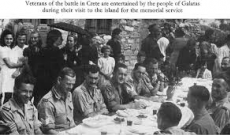
A lot of people don’t know about this tiny part of the Second World War, because it’s not something we learn about in school. We really should, though, as learning about the battle and occupation of this beautiful island helps us to understand how resistance movements work, how modern warfare has changed, but most importantly just how brutal the Nazis were. We already know about concentration camps, but what happened to those civilians who risked their lives for the chance to get freedom?
The battle itself was only ten days long, between May 20th and June 1st 1941. Hitler asked as the Battle wore on longer than expected – “France fell in 8 days – why is Crete taking so long?” Bear in mind that France was a big industrial power and a huge country to boot, whereas Crete was a comparatively small island with a largely rural population. The main battles sites were at the Akrotiri peninsula, where Chania airport is today, and the main towns of Crete – Chania, Heraklion and Rethymno. There were also battles and the destruction of entire villages in the centre of Crete, in the mountains.
The battle of Crete was the first battle to use paratroopers as the main invading force. This means that instead of troops sailing in and invading the ports, or landing at airports and conquering from there, German planes flew over the island and dropped thousands of troops with parachutes. They landed in multiple different locations across Crete, so in a way it was quite an effective and innovative method of invading. The battle is also known for its naval fighting, with the boats in the sea battling it out for control of the waters around the main port cities. If you’ve seen the film The Imitation Game recently, you’ll know it was Alan Turing at Bletchley Park that helped crack the German Enigma code. Well, after this code was cracked, Allied forces first put their knowledge of the code to the test at the Battle of Crete. They had to be very careful to make sure the Nazis were unaware of their success, so people who worked with the radios were very well protected.
By this time you are probably asking – with such a powerful enemy, how did the people of Crete manage to hold out for so long? Well, this was the first time the German army had encountered civilian resistance of this proportion. Everybody got involved – from small children to grandmothers, most of the island fought with whatever weapons they could. Crete has had a long history of being occupied by foreign invaders, and only just after gaining freedom in 1913, they were not about to give it up again.
So, what led to the Germans winning? Unfortunately, makeshift and outdated weapons being used by the civilians were no match for the Nazi war machine. They also had a strategic advantage, as they had more troops and they also had the Italian army on side too. They also managed to capture a crucial airfield due to a miscommunication between the Allies. However, the victory for the Nazis was not a sweet one. Though they had won, they lost so much troops and equipment it left their resources severely depleted. Hitler himself banned all major airborne occupations for the future, meaning that Crete was the first and last major battle to use paratroopers.
Image from: http://nzetc.victoria.ac.nz/tm/scholarly/WH2-2Ita-fig-WH2-2ItaP051b.html

0 Comment:
Be the first one to comment on this article.